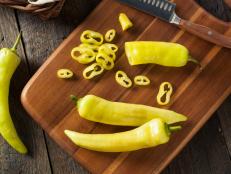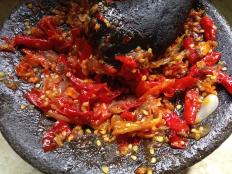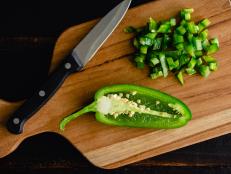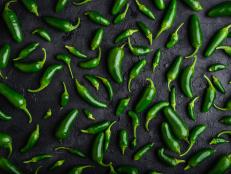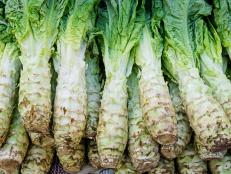From the Competition to Your Kitchen: Chile Pepper Cheat Sheet

2015 Food Network
The Food Network Star competition got spicy during the first round when the contestants were forced to give up their most-prized ingredients. Eddie had to trade his habaneros to Michelle in exchange for her grape leaves. Michelle was a little intimidated by the heat that habaneros pack — and we totally sympathize! They’re loaded with capsaicin, the active compound in chile peppers that gives them their spice and tingle (that’s why Michelle slipped on plastic gloves before she cut them). A little can go a long way, which is why she was so cautious — although the mentors ended up thinking her dish could have used more.
There’s even a way to measure how spicy chiles are; it’s called the Scoville Scale, based on Scoville Heat Units (SHU). Habaneros are some of the hottest peppers around (100,000 to 350,000 SHU) — although Michelle is lucky she didn’t have to contend with the infamous ghost pepper, which can top the charts at a whopping 1 million SHU!
Here’s how other chile peppers compare to habanero and ghost:
Ghost: (800,000 to 1 million) Known as bhut jolokia in its native northeastern India. Notoriously the world’s hottest pepper — to be used with caution!
Habanero: (100,000 to 350,000) Commonly used in Jamaican cooking, these potent little guys range in color from orange to brown.
Serrano: (15,000 to 25,000) A skinny green Mexican pepper that’s great in salsas or even pickled.
Fresno: (2,500 to 10,000) Much like the jalapeno (but bright red), they’re great in ceviche or salsas.
Jalapeno: (2,500 to 10,000) The most popular chile in the United States, grown in both green and red varieties. When dried and smoked, it becomes chipotle.
Poblano: (1,000 to 2,000) Most notably used for the Mexican dish chiles rellenos. The skin is easy to blister and peel.
Anaheim: (1,000 to 1,400) Named for a town in California, these celery-colored peppers are great roasted or stuffed.
Cherry: (100 to 500) Round, red and hot — these are great pickled.
Shishito: (0 to 2,000) Hailing from Japan and gaining popularity here in the United States, these peppers have thin skins and are great cooked hot and fast until they blister.
Banana: (0 to 500) Great pickled; you’ve probably encountered these guys on pizza.
Bell: (0) Crunchy and sweet. Seek spiciness elsewhere!
There aren’t that many Food Network Star finalists remaining! See who gets to stay next Sunday at 9|8c.
Photo courtesy of Heather Ramsdell
























